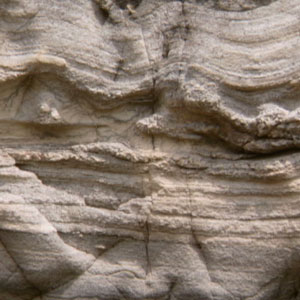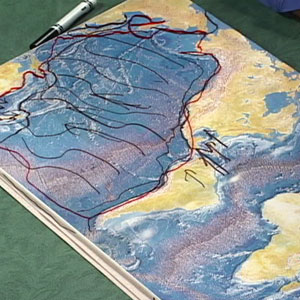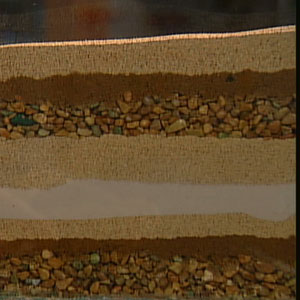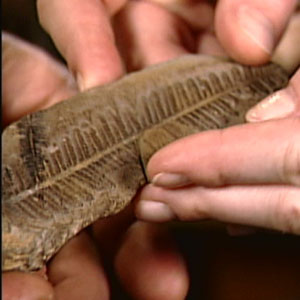Join us for conversations that inspire, recognize, and encourage innovation and best practices in the education profession.
Available on Apple Podcasts, Spotify, Google Podcasts, and more.
Look for the following topics in the video, indicated by the ![]() onscreen icon, and click below to learn more.
onscreen icon, and click below to learn more.
 Sedimentary Rocks |
 Fossils |
 Supercontinents |
Have you ever looked at an outcropping of rock and noticed that it’s made of bands of different colors and/or textures? Those layers that you’re seeing are the telltale sign that you’ve found sedimentary rock. Sedimentary rock covers most of the Earth’s surface. The layers in sedimentary rocks are formed from the weathered products of other rocks (igneous, metamorphic, or sedimentary rocks). These products are rock fragments called sediment. Sediment can range in size from the tiniest particles of clay to boulders. Sedimentary rock forms at or near the Earth’s surface at relatively low temperatures and pressures, and usually in water.

Model of the sedimentary process of deposition.
Deposition
Sediments that form sedimentary rocks can be transported by several mechanisms that include wind, ice, and, most commonly, moving water. As the energy of water currents decreases — as when a river or stream empties into a lake or ocean — the sediments settle out of the water due to gravity. The heavier and larger particles, such as gravel and sand, settle first. The lighter sediments, such as silt and clay, settle last. This laying down of sediments by natural processes is called deposition.
Compaction, Recrystallization, and Cementation
The deposited sediments gradually accumulate, forming layers. The weight of the overlying sediment compacts the sediment below. This compaction squeezes together the layers of sediment, forcing the grains together, making the pore spaces around each grain smaller, and squeezing out some of the water. The remaining water surrounding the sediments can contain dissolved minerals, which later recrystallize as new minerals in the pore spaces. The crystals interlock and connect the sediment grains, which essentially “glues” the sediment together. This forms solid rock. Further compaction and burial can cause additional recrystallization, making the rock even harder. Calcite and silica are common minerals that cement individual sediments together. Rocks formed in this way are called clastic sedimentary rocks because the rock is composed of “clasts” or individual sediments.
Chemical Processes
Sediments that have precipitated out of solution form chemical sedimentary rocks. Sedimentary rocks formed by the evaporation of sea or lake water are called evaporites. As water evaporates, the concentration of the salt solids (salt meaning soluble compounds, not just the familiar sodium chloride commonly known as table salt) increases and the amount of water decreases. Halite and gypsum are examples of evaporites.
Biological Processes
Biological processes can form sedimentary rocks in which the layers are formed from the remains of plants and animals. In warmer, shallower ocean water, layers of limestone can form from the accumulation of the calcium carbonate that composes the shells and skeletons of coral, shellfish, and other marine organisms. In colder, deeper waters, layers of sediment can form from the remains of microorganisms called foraminiferans and diatoms, which secrete shells of calcium carbonate or silica. Rocks formed in this way are called biochemical sedimentary rocks.
Biological processes also form sedimentary rocks from the accumulation and compaction of dead plant material, typically under wet, acidic conditions in regions with an abundance of growing vegetation. The vegetation proliferates so quickly that new layers of vegetation rapidly bury the dead and decaying plant material. When buried like this, the bacteria use up the oxygen that is available and cannot finish the decomposition of the vegetation. This matter may change to solid carbon in the form of coal, or be converted to hydrocarbons, the source of petroleum oil.

Fossilized leaf.
Fossils are either the preserved remains of ancient animals and plants, their imprints, or the traces of their activities. Fossils are most often preserved in sedimentary rock. However, organisms preserved in ice, or organic matter such as amber or tar, are also considered fossils if the organisms are from the prehistoric past.
Fossilization is a rare event. The chances of a given individual plant or animal becoming a fossil are very small. The hard skeletons and shells of animals and hard woody plant structures are more likely to become fossilized than the soft tissues of organisms. Fossilization is also more likely to occur in marine environments. Even if fossils are able to form, they may not be preserved intact. For example, in some cases, sedimentary rock that is buried and compacted experiences temperature and pressure increases that can melt and deform it, changing it to metamorphic rock. Fossils preserved in sedimentary rock that becomes metamorphic rock are usually distorted or destroyed.
Unaltered Preservation
When organisms become trapped in substances such as amber, tar, or ice, their remains can be preserved unchanged. In some cases, the structure of the organism’s soft tissue is even preserved.
Petrifaction
When petrifaction occurs, mineral-rich fluids slowly seep into the cells of an organism and crystallize, displacing the original organic matter. Petrifaction is also referred to as permineralization. Most bone and wood fossils are permineralized.
Replacement
When an organism is buried in mud, the minerals that make up its hard parts can dissolve and be replaced by different minerals such as calcite or silica. This process can preserve the soft tissue of organisms, providing important information on ancient organismal structures.
Carbonization
This process is also referred to as coalification. Plants are usually preserved through this process when bacteria decay the plant material and in doing so release elements like hydrogen, oxygen, and nitrogen. This reduces most of the remaining matter to carbon.
Recrystallization
Many aquatic animals have shells composed of a form of calcium carbonate that will change into calcite, a more stable mineral, over millions of years. This process also rearranges small calcite crystals into larger crystals, preserving the original material but destroying its original structure.
Authigenic Preservation
Fossilized organisms preserved in rock can be destroyed or dissolved leaving an empty space in the rock where there once was an organism. The impression that is left behind in the rock is called an external mold. Sometimes the inside of a shell is filled with sediment before the shell dissolves or is destroyed. This is an internal mold. If the shell is filled with a new mineral, the shell replica is called a cast.

Science studio diagram of continental drift.
Long before the theory of plate tectonics became accepted, there was much speculation that the present-day continents were the fragmented pieces of pre-existing larger landmasses called supercontinents. The belief that the modern continents have not always been in their present positions has long been held. As early as the 1500s, many geographers and mapmakers noticed the close match of the coastlines of South America and Africa. The fit is even more striking when the continental shelves (submerged edge of a continental plate) and the continental slopes (the true boundary of a continent) are compared rather than the coastlines. It was not until 1912, however, that the idea of moving continents was seriously considered as a scientific theory. This theory, called continental drift theory, was the precursor to plate tectonics theory and was introduced by Alfred Wegener.
Scientists believe there have been several supercontinental arrangements in the history of the Earth. The first known supercontinent is called Rodinia (from Russian, meaning “homeland”), and it is thought to have formed about 1.1 billion years ago. Although the exact size and configuration of Rodinia cannot be estimated, rocks of ancestral North America are thought to have formed the core of the giant continent. About 750 million years ago, evidence suggests that Rodinia fragmented into pieces that drifted apart. Approximately 600 million years ago, those pieces collided again forming a new supercontinent, Pannotia.
Scientists think Pannotia broke up about 550 million years ago into several smaller fragments: Laurentia (the core of what is now North America), Baltica (northern Europe), other small fragments, and one very large fragment called Gondwanaland, which contained the land from modern-day China, India, Africa, South America, and Antarctica. Between 550 and 350 million years ago, Laurasia, a landmass comprised of North America and Eurasia, was formed. Laurasia and Gondwanaland then joined to form the supercontinent of Pangaea (from classical Greek, meaning “all lands”). Evidence suggests that Pangaea began to break up about 225 million years ago, and continues to separate into the modern continents we know today.
The process of supercontinent assembly, breakup, dispersal and re-assembly takes, on average, about 500 million years. This supercontinent cycle is called the Wilson Cycle after J. Tuzo Wilson, the Canadian geologist who first described it.